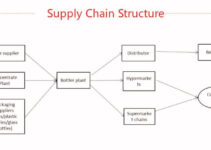Predictive analytics have the capability to increase retail sales by 30%. It is the strategic approach of employing ML (machine learning) strategies, algorithms, and historical and real-time data to predict future outcomes and make database decisions. Predictive analytical tools are a game changer in a highly competitive retail industry. Today, we’ll discuss retail supply chain predictive analytics; its key elements; application and usage, and examples of predictive analytics in the retail industry.
Predictive Analytics is improving the customer experience in the following ways;
- Personalized product suggestions and recommendations based on the customer’s shopping history and data
- Learning about customer needs, wants, and preferences by comprehending their shopping patterns, queries, and interactions
- Improving the customer satisfaction level
- Building brand loyalty among users and customers
- Connecting and engaging with the targeted customers
Factors Improving Sales and Profitability in Predictive Analytics
- Targeted marketing and promotional campaigns
- Recognizing cross-selling and up-selling strategies and opportunities
- knowing the relationship between different products and customers’ shopping patterns
- Improving promotional and pricing strategies to gain a maximum from it
Key Elements of Retail Supply Chain Predictive Analytics
Let’s discuss the key elements of retail supply chain predictive analytics are as follows;
Predictive Analytics
Predictive analytics is the method of employing machine learning, algorithms, statistical models, and data analysis strategies to recognize patterns and forecast the future. It comprises evaluating the historical data to forecast inventory levels, sale trends, and customer behavior.
Gather Data and Preparation
The first stage in predictive analysis is gathering and preparing data. It comprises gathering data from multiple sources, cleaning, managing, and organizing it to ensure its quality and integrity.
Descriptive Analysis
The descriptive analysis comprises evaluating data to comprehend the events and incidents that have happened in the past. It offers you a key insight into recognizing historical data, patterns, and trends. The descriptive analysis serves as a foundation and base of predictive analysis.
Predictive Modeling
Predictive modeling is the systematic method and process of building and creating mathematical models to forecast future outcomes based on historical data. It comprises of choosing the right algorithm, training the model based on the data, and validating the performance.
ML Algorithm
The predictive analysis employs different machine learning algorithms like; neural networks, supporting vector machines, random forecasting, decision trees, logistic regression, and linear regression. Every algorithm has its own strengths and weaknesses, and whatever algorithm you choose depends on specific data characteristics and the problems.
Choosing Feature
The selection of feature comprises of recognizing the most relevant variables and features that contribute significantly to the accuracy of the predictive models. Feature and variable engineering comprises of transforming and developing new features from the current data to improve the performance of models.
Monitoring and Validating
After developing the predictive model, it is necessary to validate and evaluate its performance based on various metrics and strategies. It allows you to analyze the generalizability, reliability, and accuracy of the new data.
Implementation and Deployment
Once the predictive analysis is considered satisfactory, they could implement it in the production environment to make predictions in real-time. It is significant to measure the performance of the model in real time and update it regularly to measure and maintain its effectiveness.
Application of SC Predictive Analytics in the Retail Industry
Some of the main applications and usages of retail supply chain predictive analytics are as follows;
Detecting Fraudulent Activities
The detective model allows you to recognize and avoid fraudulent activities like product return fraud or credit card fraud. The retailers could recognize suspicious activities by analyzing various patterns, historical data, and anomalies; they can decrease the risk rate by taking appropriate measures.
Optimizing Price
The predictive models would guide retailers to amplify their pricing strategies. Retailers could find the optimum price for products and services by analyzing market trends, customer behavior, and competitors’ price ranges. The optimum price allows them to amplify their sales and profitability.
Churn Prediction
The retailers employ the predictive model to recognize the customers who are on the verge of discontinuing their relationship with the brand. They would take precautionary measures to retain their loyal customers by analyzing customer engagement practices, transaction history, and customer behavior.
Segmenting Customers
The supply chain predictive analysis helps retailers to recognize and categorize their customers based on their buying history, preferences, behaviors, and demographics. It allows them to launch personalized marketing campaigns, recommendations, and targeted efforts based on customer satisfaction level and brand loyalty.
Forecasting Demand
The predictive model allows you to forecast and predict the customer demand for products, goods, and services. It follows the historical sales data, seasonality, performance, promotion, and other factors; the retailers could forecast the future demand to make efficient production planning, supply chain management, and optimizing inventory levels.
Examples of SC Predictive Analytics in the Retail Industry
Some of the main examples of SC predictive analytics in the retail industry are as follows;
Walmart
Walmart employs predictive analytical tools for optimizing inventory and forecasting customer demand. The retail chain brand has the capability to rightly forecast demand by analyzing weather patterns and historical sales data. It allows them to ensure the availability of the right product in various stores.
Amazon
Amazon greatly employs the SC predictive analytical tools for personalized product recommendations to customers. It comprises analyzing customers browsing history and shopping patterns; the platform recommends and suggests the right products to the customers.
Conclusion: Supply Chain Predictive Analytics in Retail Industry | Retail Supply Chain Predictive Analytics
After an in-depth study of the retail supply chain predictive analytics; we have realized that predictive analysis plays a critical role in efficiently performing its role. If you are learning about supply chain predictive analysis in the retail industry; then you should keep in mind the abovementioned elements, applications, examples, and factors.
Ahsan is an accomplished researcher and has a deep insight in worldly life affairs. He goes Live 3 days a week on various social media platforms. Other than research writing, he’s a very interesting person.


